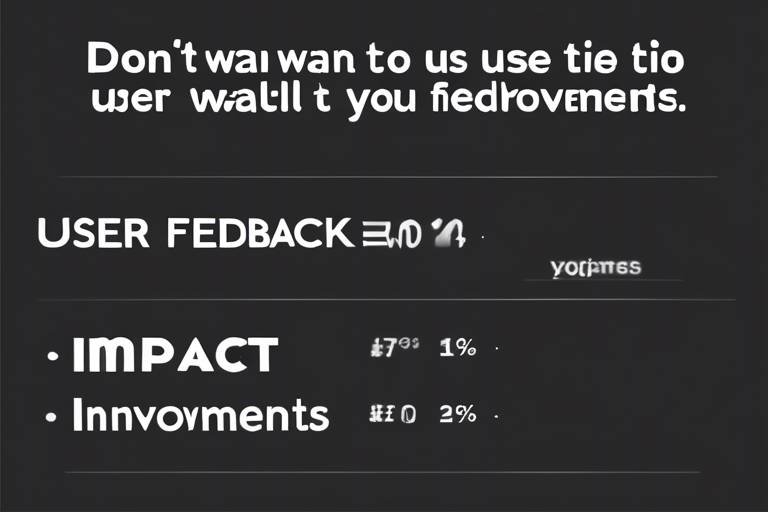The Importance of Wallet Transparency for User Trust
In today's digital age, where financial transactions are just a click away, the concept of wallet transparency has emerged as a cornerstone for building trust among users. Imagine walking into a bank where every transaction is visible, every balance is clear, and every fee is disclosed upfront. Wouldn't that make you feel more secure? That's precisely what wallet transparency aims to achieve in the realm of digital finance. By providing users with clear insights into their financial activities, platforms can foster a sense of confidence and reliability that is essential for long-term success.
Wallet transparency isn't just about showing off numbers; it's about creating a culture of openness that resonates with users. When individuals can easily track their transactions and balances, they are more likely to engage with the platform actively. This engagement leads to a healthier financial ecosystem where users feel empowered to make informed decisions. It's like having a well-lit path in a dark forest; it helps users navigate their financial journeys without fear of stumbling into pitfalls.
Moreover, in an era where fraudulent activities are rampant, transparency acts as a deterrent. When users can scrutinize their transaction history and identify anomalies, it becomes significantly harder for fraudsters to operate undetected. This not only protects the users but also enhances the platform's reputation, making it a go-to choice for those seeking a trustworthy financial service.
In essence, wallet transparency is more than just a feature; it's a promise. A promise of security, accountability, and integrity. As we delve deeper into the nuances of this topic, we'll uncover how wallet transparency not only builds user trust but also aligns with regulatory compliance, ensuring that platforms operate within the legal frameworks designed to protect user interests.

Understanding Wallet Transparency
Wallet transparency is more than just a buzzword in the realm of digital finance; it's a crucial element that defines how users interact with their financial platforms. At its core, wallet transparency refers to the clarity and openness regarding the transactions and balances within digital wallets. Imagine walking into a bank where every transaction is displayed on a big screen for everyone to see. While that might sound extreme, the idea is to create a similar level of openness in the digital world. When users can easily access and understand their financial data, it fosters a sense of trust and security.
In today's fast-paced digital economy, users demand accountability and integrity from the platforms they use. They want to know where their money is going, how much they have, and whether they can trust the system that holds their assets. Wallet transparency plays a pivotal role in achieving this. By providing users with a clear view of their transaction history, balances, and even the fees associated with transactions, platforms can eliminate confusion and build a solid foundation of trust.
Furthermore, wallet transparency is not just beneficial for users; it also serves as a protective measure for financial platforms themselves. When users can see their transactions, they are less likely to dispute charges or claim fraud, which can lead to a more harmonious relationship between users and providers. This transparency can significantly reduce the number of fraudulent claims and disputes, ultimately saving time and resources for both parties.
However, achieving wallet transparency is not without its challenges. Financial platforms must navigate the delicate balance between providing enough information to satisfy user curiosity and protecting sensitive data from potential threats. This is where the concept of data privacy comes into play. Users want to feel secure in their transactions without the fear of their personal information being exposed or misused. Therefore, while transparency is essential, it must be implemented thoughtfully, ensuring that user data remains protected.
To sum it up, understanding wallet transparency is about recognizing its importance in building a trustworthy digital finance ecosystem. It’s about creating a space where users feel empowered to manage their finances confidently. As we delve deeper into this topic, we will explore the benefits of wallet transparency and how it can enhance user confidence, reduce fraud risks, and encourage accountability.

Benefits of Wallet Transparency
Wallet transparency is not just a buzzword; it’s a fundamental aspect of modern digital finance that carries a multitude of benefits. When users can clearly see their transaction history and wallet balances, it creates a sense of **security** and **trust**. Imagine walking into a bank where all transactions are displayed on a large screen—wouldn't that make you feel more at ease about your finances? The same principle applies here. By promoting transparency, digital wallet providers can significantly enhance user experience and foster a more trustworthy environment.
One of the most significant advantages of wallet transparency is that it actively reduces fraud. When users have access to detailed records of their transactions, it becomes much easier to spot any suspicious activity. For instance, if a user notices an unfamiliar transaction, they can quickly report it. This immediate feedback loop not only helps the individual but also alerts the platform to potential vulnerabilities. As a result, transparent wallets serve as a deterrent for fraudsters, knowing that their actions are more likely to be detected.
Moreover, wallet transparency encourages responsible financial behavior. When individuals can track their spending habits and see where their money is going, they are more likely to make informed decisions. This visibility acts as a gentle nudge towards better financial management. Users can create budgets, set savings goals, or even identify unnecessary subscriptions that are draining their wallets. In essence, this transparency transforms users from passive participants into active managers of their financial destiny.
Another key benefit is the enhancement of user accountability. With a clear view of their financial activities, users are more likely to take ownership of their decisions. They can reflect on their spending patterns and recognize areas where they might improve. This accountability not only fosters a sense of responsibility but also cultivates a culture of **financial literacy**. As users become more knowledgeable about their finances, they are empowered to make choices that benefit their long-term financial health.
Furthermore, wallet transparency plays a crucial role in ensuring regulatory compliance. Many financial regulations require platforms to maintain a level of transparency to protect consumer interests. By adhering to these regulations, wallet providers not only safeguard their users but also enhance their credibility in the market. This compliance can lead to a competitive advantage, attracting users who prioritize security and transparency in their financial dealings.
In summary, the benefits of wallet transparency extend far beyond mere visibility. They encompass trust, fraud reduction, responsible behavior, accountability, and compliance. By embracing transparency, digital wallet providers can create a more secure and user-friendly environment that ultimately benefits everyone involved.
- What is wallet transparency? Wallet transparency refers to the clear visibility of transaction histories and balances within digital wallets, enhancing user trust.
- How does wallet transparency reduce fraud? By providing users with access to their transaction details, it becomes easier to identify and report suspicious activities.
- Why is accountability important in wallet transparency? Accountability encourages users to take responsibility for their financial decisions, leading to better financial management.
- What role does regulatory compliance play? Compliance with financial regulations ensures that digital wallets operate within legal frameworks, protecting user interests.

Enhancing User Confidence
When it comes to digital finance, user confidence is everything. Imagine walking into a bank where you can see every transaction, every balance, and every detail of your account—all laid out in front of you. This level of transparency is what enhances user confidence in digital wallets. When users can easily access their transaction history and monitor their wallet balances, it creates a sense of security that is often lacking in less transparent systems.
Transparency in wallet operations allows users to feel more in control of their finances. With the ability to track their spending habits and see where their money goes, users can make informed decisions. They can identify patterns in their usage, which not only aids in budgeting but also empowers them to take charge of their financial future. For example, if a user notices they are spending excessively on subscriptions, they can take action to cut down, ultimately leading to better financial health.
Moreover, when users feel they are part of an open system, they are more likely to engage with the platform. This engagement can lead to a more vibrant community where users share tips, advice, and even warnings about potential scams or fraudulent activities. This communal aspect of wallet transparency can foster a collaborative environment that benefits everyone involved. In fact, studies have shown that platforms that prioritize transparency often see higher user retention rates.
Let's not forget about the psychological aspect of transparency. Just as we trust a friend more when they are open about their thoughts and feelings, users are more likely to trust a financial platform that operates transparently. This trust can lead to increased user loyalty, which is invaluable in the competitive world of digital finance. Users are less likely to jump ship to another platform if they feel they can rely on the one they are using.
In summary, enhancing user confidence through wallet transparency is not just about numbers and transactions. It’s about creating an ecosystem where users feel safe, informed, and empowered. This trust is the cornerstone of successful digital finance platforms, ultimately leading to a more robust and secure financial environment for everyone.

Reducing Fraud Risks
In the world of digital finance, the threat of fraud looms large, casting a shadow over user confidence and platform integrity. However, one of the most powerful tools in combating this menace is wallet transparency. By providing users with a clear view of their transaction history and wallet balances, platforms can significantly diminish the likelihood of fraudulent activities. Imagine walking into a store where every item is clearly marked with its price, and every transaction is visible to all. This level of transparency not only deters potential wrongdoers but also empowers users to monitor their accounts actively.
Transparent wallets allow for the identification of unusual or suspicious transactions, which can be flagged for further investigation. Users are encouraged to report any discrepancies they notice, creating a community-driven approach to security. When users can see their entire transaction history, they are more likely to spot anomalies. For instance, if a user notices a transaction they did not authorize, they can quickly alert the platform, which can then take immediate action.
Moreover, platforms can implement real-time alerts for transactions that fall outside of a user’s typical spending patterns. This proactive measure acts as a safety net, catching potential fraud before it escalates. Here are some ways wallet transparency contributes to reducing fraud risks:
- Immediate Reporting: Users can quickly report any unauthorized transactions.
- Pattern Recognition: Users can recognize their spending habits and identify irregularities.
- Community Vigilance: A transparent system fosters a community where users help one another stay safe.
Additionally, regulatory bodies often require a degree of transparency, which means that compliant platforms are already implementing measures to reduce fraud risks. This not only protects the users but also builds a reputation of reliability for the platform itself. In a landscape where trust can make or break a financial service, having a transparent wallet isn’t just a feature; it’s a necessity.
In conclusion, by embracing wallet transparency, digital finance platforms can create a safer environment for users, significantly reducing the risks of fraud. It’s a win-win situation where users feel secure, and platforms can thrive without the looming fear of fraudulent activities undermining their credibility.
- What is wallet transparency? Wallet transparency refers to the openness regarding transactions and balances within digital wallets, allowing users to track their financial activities.
- How does wallet transparency reduce fraud? By providing clear visibility into transactions, users can quickly identify and report suspicious activities, thereby reducing the chances of fraud.
- Are there privacy concerns with wallet transparency? Yes, some users may worry about their personal information being exposed; hence, balancing transparency with security is crucial.

Encouraging Accountability
In today's digital world, where financial transactions happen at the speed of light, is more crucial than ever. When users have clear visibility into their transactions, they are more likely to take ownership of their financial decisions. Imagine having a personal finance coach right in your pocket, guiding you through your spending habits and helping you make better choices. This is exactly what transparent wallets provide! By allowing users to track their spending, they can identify patterns and make informed decisions that align with their financial goals.
Moreover, accountability fosters a sense of responsibility. When users can see where their money is going, they are less likely to engage in reckless spending or fraudulent activities. It's like having a mirror that reflects not just your balance but also your habits. For instance, if someone notices a recurring subscription they forgot about, they can take immediate action to cancel it, thus saving money and making more thoughtful choices in the future.
Furthermore, transparency in digital wallets can lead to a community of users who support each other in their financial journeys. This can be achieved through features that allow users to share their achievements, such as reaching a savings goal or sticking to a budget. By creating a culture of sharing and encouragement, users can inspire one another to remain accountable and responsible with their finances. This sense of community can be further enhanced through social features embedded within wallet applications, where users can celebrate milestones and provide tips to each other.
To illustrate the impact of encouraging accountability through wallet transparency, consider the following table that showcases the benefits:
| Benefit | Description |
|---|---|
| Informed Decision-Making | Users can analyze their spending patterns and make better financial choices. |
| Reduced Reckless Spending | Visibility into transactions discourages impulsive purchases. |
| Community Support | Users can encourage each other, fostering a culture of accountability. |
In conclusion, encouraging accountability through wallet transparency is not just about seeing numbers on a screen; it's about empowering users to take control of their financial lives. With the right tools and a supportive community, individuals can transform their relationship with money, leading to healthier financial habits that benefit everyone involved.
- What is wallet transparency? Wallet transparency refers to the openness and clarity regarding transactions and balances within digital wallets.
- How does wallet transparency enhance user confidence? When users can see their transaction history and wallet balances, it boosts their confidence in the platform's security and reliability.
- What are the privacy concerns associated with wallet transparency? Users may fear that their personal information could be exposed or misused by third parties, which can deter them from embracing transparency.
- How can digital wallet providers balance transparency and security? They must implement robust security measures while ensuring users have access to their transaction data without compromising privacy.

Regulatory Compliance
In today's digital finance landscape, plays a pivotal role in ensuring that financial platforms operate within legal frameworks. This is particularly crucial for digital wallets, where the transparency of transactions not only helps in building user trust but also aligns with regulatory standards. Compliance with regulations, such as the Financial Action Task Force (FATF) guidelines and local laws, mandates that wallet providers maintain clear records of user transactions and balances. This transparency is essential in preventing money laundering and other illicit activities, which authorities are keen to combat.
Moreover, regulatory compliance facilitates a safer environment for users. When a wallet provider adheres to established laws, it signals to users that their funds are secure and that the platform is committed to ethical practices. This commitment enhances user confidence, encouraging more individuals to engage with digital finance. For instance, by implementing Know Your Customer (KYC) protocols, wallet providers can verify the identities of their users, which not only helps in compliance but also deters fraudulent activities.
However, achieving compliance is not without its challenges. Wallet providers must navigate a complex web of regulations that can vary significantly from one jurisdiction to another. This often requires a robust compliance framework that includes:
- Regular audits: Ensuring that all transactions are accurately documented and that the platform adheres to regulatory standards.
- Data protection measures: Implementing stringent security protocols to safeguard user data while remaining compliant with privacy laws.
- Continuous training: Educating staff about the latest regulatory requirements and best practices in financial compliance.
In summary, wallet transparency is not just a best practice but a necessity for regulatory compliance. It helps to create a trustworthy environment that protects users while also ensuring that financial platforms meet the legal obligations set forth by authorities. As the digital finance ecosystem continues to evolve, the importance of maintaining regulatory compliance through transparency will only grow.
- What is wallet transparency? Wallet transparency refers to the openness and clarity regarding the transactions and balances within digital wallets.
- Why is regulatory compliance important for digital wallets? Regulatory compliance ensures that wallet providers operate within legal frameworks, helping to prevent fraud and protect user interests.
- How does transparency enhance user trust? When users can easily access their transaction history and wallet balances, it increases their confidence in the security and reliability of the platform.
- What are the challenges of implementing wallet transparency? Challenges include privacy concerns and the need to balance transparency with user security.

Challenges of Implementing Transparency
While the advantages of wallet transparency are compelling, implementing it is not without its challenges. One of the most significant hurdles is the privacy concerns that users often voice. Imagine opening your financial diary to the world; it’s a daunting thought! Users may hesitate to fully embrace transparency if they feel their sensitive information is at risk of exposure or misuse. In a world where data breaches make headlines almost daily, who wouldn’t be apprehensive?
Furthermore, the challenge doesn't stop at privacy. Digital wallet providers must also grapple with the balance between transparency and security. Striking this balance is akin to walking a tightrope; too much transparency can lead to vulnerabilities, while too little can erode trust. Users want to see their transaction history and balances without feeling like they’re leaving the door wide open for cybercriminals. This delicate dance requires innovative solutions that prioritize user safety while still offering the clarity and openness that wallet transparency promises.
Another challenge is the potential for misuse of information. With greater access to transaction data, there’s an increased risk that this information could be exploited by malicious actors. For instance, if a user's transaction patterns are made public, it could expose them to targeted scams or phishing attempts. This risk heightens the need for robust security measures that can safeguard user data while still allowing for the transparency that builds trust.
Moreover, the implementation of wallet transparency may also face regulatory hurdles. Different regions have varying laws regarding data privacy and financial transactions. For example, in some jurisdictions, there are stringent regulations that dictate how financial information should be handled. This patchwork of regulations can complicate the implementation process for wallet providers, as they must navigate a complex legal landscape to ensure compliance.
In summary, while wallet transparency is a powerful tool for building trust among users, it comes with its own set of challenges. Addressing privacy concerns, balancing transparency with security, preventing misuse of information, and complying with regulatory requirements are all critical factors that digital wallet providers must consider. Only by overcoming these challenges can they truly harness the power of transparency to foster a secure and trustworthy financial environment.
- What is wallet transparency?
Wallet transparency refers to the clarity and openness regarding the transactions and balances within digital wallets, which is crucial for building user confidence in financial platforms. - Why is wallet transparency important?
It promotes trust, reduces fraud, and encourages responsible financial behavior by allowing users to track their transactions and balances easily. - What are the privacy concerns related to wallet transparency?
Users may fear their personal information could be exposed or misused by third parties, leading to hesitance in embracing transparency. - How can wallet providers balance transparency and security?
They must implement robust security measures while still providing users with clear visibility into their transactions and balances.

Privacy Concerns
In today's digital landscape, privacy is a hot-button issue that cannot be ignored. With the rise of wallet transparency, many users find themselves grappling with the uncomfortable reality of how much of their personal information is exposed. Imagine walking through a crowded market where everyone can see your shopping list; that’s how some users feel about their financial activities being laid bare for all to see. The fear of having sensitive data misused or falling into the wrong hands can create a significant barrier to embracing transparent wallets.
Users may wonder: What happens to my data once it's out there? This is a valid concern. Transparency often means that transaction histories, balances, and even personal identifiers could be accessible to various entities, including hackers, advertisers, and other third parties. The potential for misuse raises alarms, leading to skepticism about whether the benefits of transparency truly outweigh the risks.
Moreover, the digital finance ecosystem is not just about technology; it’s also about trust. Users need to feel secure in knowing that their data is protected. For instance, if a wallet provider claims to offer transparency but fails to implement robust security measures, users may feel like they’re walking a tightrope without a safety net. This is where the balance between transparency and security becomes paramount. Wallet providers must ensure that while they promote transparency, they also prioritize the protection of user data through strong encryption and strict privacy policies.
To tackle these privacy concerns effectively, wallet providers can take several steps:
- Implement Strong Encryption: This ensures that even if data is transmitted, it remains unreadable to unauthorized parties.
- Educate Users: Providing information on how user data is handled can demystify the process and build trust.
- Offer Customizable Privacy Settings: Allowing users to choose what information they want to share can empower them and alleviate fears.
In conclusion, while wallet transparency is essential for fostering trust and accountability, it must be approached with caution. Providers need to ensure that users feel secure about their data, striking a balance that encourages transparency without compromising privacy. Only then can we truly harness the power of transparent wallets to create a more trustworthy digital finance landscape.
- What is wallet transparency? Wallet transparency refers to the openness regarding the transactions and balances within digital wallets, which helps build user confidence.
- How can wallet transparency reduce fraud? By allowing users to easily track their transactions, suspicious activities can be identified more quickly, reducing the likelihood of fraud.
- What are the privacy concerns associated with wallet transparency? Users may worry about their personal information being exposed or misused, leading to hesitance in adopting transparent wallets.
- How can wallet providers ensure user privacy? Implementing strong encryption, educating users about data handling, and offering customizable privacy settings can help protect user information.

Balancing Transparency and Security
In the digital finance landscape, achieving a balance between transparency and security is akin to walking a tightrope. On one side, we have the need for users to see their transactions and balances clearly, which fosters trust and accountability. On the other side, there’s the pressing concern of safeguarding personal information and preventing unauthorized access. This delicate equilibrium is critical for the success of digital wallet providers.
To illustrate, think of a transparent wallet as a glass house. While it’s beautiful to see everything inside, it also makes the contents vulnerable to prying eyes. Users want to know what’s happening with their money, but they also need assurance that their sensitive data isn’t exposed to potential threats. Thus, digital wallet providers must implement robust security measures while still offering a clear view of transaction histories.
One effective strategy is the use of encryption technologies. By encrypting transaction data, wallets can maintain transparency without compromising user security. This means that while users can see their transaction details, the actual data is protected from unauthorized access. Additionally, incorporating features like two-factor authentication adds another layer of security, ensuring that only the rightful owner can access their wallet.
Moreover, it’s essential for wallet providers to educate users about the importance of security measures. By informing users about how their data is protected and what steps they can take to enhance their own security, providers can build a more resilient user base. For instance, users should be encouraged to create strong passwords, regularly update them, and remain vigilant against phishing attempts.
Another crucial aspect of balancing transparency and security is the implementation of privacy controls. Users should have the ability to manage their privacy settings, allowing them to determine what information they wish to share and with whom. This empowers users, giving them a sense of control over their financial data while still allowing for the necessary transparency in transactions.
Ultimately, the goal is to create a user-friendly environment that prioritizes both transparency and security. As digital wallets continue to evolve, finding innovative solutions to maintain this balance will be key to enhancing user trust and ensuring the integrity of financial systems.
- What is wallet transparency? Wallet transparency refers to the clear visibility of transactions and balances within digital wallets, which helps build user trust.
- How does transparency reduce fraud? By allowing users to track their transactions easily, transparent wallets make it easier to identify suspicious activities.
- What security measures should I look for in a digital wallet? Look for wallets that offer encryption, two-factor authentication, and user-controlled privacy settings.
- Can transparency compromise my privacy? While transparency is important, it can be balanced with security measures to protect your personal information.
Frequently Asked Questions
- What is wallet transparency?
Wallet transparency refers to the openness and clarity regarding the transactions and balances within digital wallets. It allows users to see their transaction history and current balances, which is essential for building trust in financial platforms.
- How does wallet transparency enhance user confidence?
When users can easily access their transaction history and wallet balances, it boosts their confidence in the security and reliability of the platform. This visibility reassures users that their funds are managed properly and that they have control over their financial activities.
- Can wallet transparency help reduce fraud?
Absolutely! Transparent wallets make it easier to identify suspicious transactions and patterns, which can significantly decrease the potential for fraudulent activities. Users are more likely to report anomalies when they have clear visibility into their transactions.
- What are the benefits of wallet transparency?
Wallet transparency promotes trust, reduces fraud, and encourages responsible financial behavior. It allows users to track their transactions easily, fostering a culture of accountability and responsible spending.
- Are there any privacy concerns associated with wallet transparency?
Yes, privacy concerns can arise. Users may worry that their personal information could be exposed or misused by third parties. It’s important for digital wallet providers to implement strong security measures to protect user data while maintaining transparency.
- How can digital wallet providers balance transparency and security?
Finding the right balance involves implementing robust security protocols while still providing users with necessary visibility into their transactions. Providers must ensure that user information is protected while promoting an open and trustworthy financial environment.
- Is wallet transparency required for regulatory compliance?
Yes, wallet transparency is often a requirement for compliance with financial regulations. It helps ensure that platforms operate within legal frameworks, protecting user interests and enhancing the overall integrity of the financial system.



















